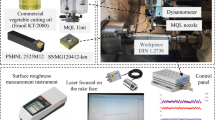Abstract
Traditional cooling methods used to irrigate coolants are not environment friendly and economical. An innovative idea, which is environment friendly, is to integrate a transcalent device without outer driving-heat pipe, into the structure of cutter. Cutting parameters directly affect removing material efficiency and shape of the cutting chip, which affects flow of cutting heat. Thermal conductivities of cutting tool and workpiece affect heat transmission and distribution across the machining system. In this paper, cutting experiments and finite element simulations were carried out to explore the impact of workpiece and cutter materials and three cutting parameters on the cooling effect of heat pipe-embedded cutter. Cooling effect of the heat pipe embedded into cutter was significantly higher than the ordinary cutter. About 40 % of the heat flowing into the cutter was transferred by the heat pipe; temperature at the measurement point of rake face decreases by about 50 ∘C; highest temperature of cutter decreased by about 200 ∘C. Cooling effect of the embedded heat pipe was affected by the materials of workpiece and cutter, and cutting parameters as well. The heat pipe transfers heat more efficiently when there is a large heat flux causing a more efficient decrease in the temperature of tool bit when difficult-to-cut metal was machined. Compared to other cutting parameters, cutting speed has a dominant effect on the cooling of the heat pipe.
Similar content being viewed by others
References
Zhou ZH (1993) Principles of metal cutting. Science and Technology Press, Shanghai(in Chinese)
Jiang FL, Liu ZQ, Wan Y, Shi ZY (2013) Analytical modeling and experimental investigation of tool and workpiece temperatures for interrupted cutting 1045 steel by inverse heat conduction method. J Mater Process Technol 213:887–894
Komanduri R, Zhen BH (2001) Thermal modeling of the metal cutting process—Part II: temperature rise distribution due to frictional heat source at the tool-chip interface. Int J Mech Sci 43:57–88
Judd RL, Aftab K, Elbestawi MA (1995) An investigation of a heat pipe cooling system for use in turning on a lathe. Int J Mach Tools Manuf 10:357–366
Vasiliev LL (2005) Heat pipes in modern heat exchangers. Appl Therm Eng 25(1):1–19
Chiou RY, Lu L, Chen JSJ, North MT (2007) Investigation of dry machining with embedded heat pipe cooling by finite element analysis and experiments. Int J Adv Manuf Technol 31:905–914
Jen TC, Gutierrez G, Eapen S, Barber G, Zhao H, Szuba P, Labataille J, Manjunathaiah J (2002) Investigation of heat pipe cooling in drilling applications. Part I: preliminary numerical analysis and verification. Int J Mach Tools Manuf 42:643–652
Liu ZJ, Quan YM (2012) Optimization of basic structure for thermal dissipation of heat-pipe milling cutter. J South China Univ Technol (Natural Science Edition) 40(12):47–52
He QS, Fu YC, Xu HJ, Ma K (2014) Investigation of a heat pipe cooling system in high-efficiency grinding. Int J Adv Manuf Technol 70:833–842
Zhu L, Peng SS, Yin CL, Jen TC, Cheng X, Yen YH (2014) Cutting temperature, tool wear, and tool life in heat-pipe-assisted end-milling operations. Int J Adv Manuf Technol 72:995–1007
Wu Z, Deng JX, Su C, Luo C, Xia D (2014) Performance of the micro-texture self-lubricating and pulsating heat pipe self-cooling tools in dry cutting process. Int J Refract Met Hard Mater 45:238–248
Zhu L, Jen TC, Yin CL, Kong XL, Yen YH (2013) Investigation of the feasibility and effectiveness in using heat pipe-embedded drills by finite element analysis. Int J Adv Manuf Technol 64:659–668
Zhu L, Jen TC, Yin CL, Kong XL, Yen YH (2012) Experimental analyses to investigate the feasibility and effectiveness in using heat-pipe embedded end-mills. Int J Adv Manuf Technol 60:497–504
Liang L, Quan YM, Ke ZY (2011) Investigation of tool-chip interface temperature in dry turning assisted by heat pipe cooling. Int J Adv Manuf Technol 54(1/2/3/4):35–43
Liang L, Quan YM (2013) Investigation of heat partition in dry turning assisted by heat pipe cooling. Int J Adv Manuf Technol 66(9-12):1931–1941
Author information
Authors and Affiliations
Corresponding author
Rights and permissions
About this article
Cite this article
Quan, Y., Mai, Q. Investigation of the cooling effect of heat pipe-embedded cutter in dry machining with different thermal conductivities of cutter/workpiece materials and different cutting parameters. Int J Adv Manuf Technol 79, 1161–1169 (2015). https://doi.org/10.1007/s00170-015-6889-5
Received:
Accepted:
Published:
Issue Date:
DOI: https://doi.org/10.1007/s00170-015-6889-5




